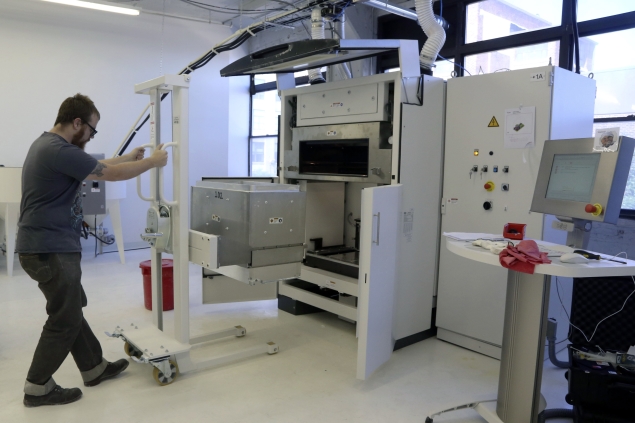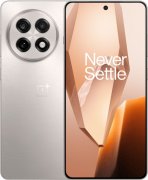Some of the oddest items on display this week at the
International CES gadget show were edible, origami-like sculptures made
of sugar, their shapes so convoluted as to baffle the eye.
The
treats are one of many signs that we'll all be getting a taste of 3D
printing soon -and the phenomenon won't be relegated to the realm of
engineers and tech enthusiasts.
The sugar sculptures are the
output of the ChefJet Pro, the first commercial, kitchen-ready food
printer. It looks like an oven, and deposits sugar layer by layer in a
tray, then melts the parts intended for the sculpture with water so they
solidify much like sugar in a bowl will harden with moisture.
Ink
can be selectively added to the water so the sculptures come out in
full color - a feature sure to set the minds of wedding and party
planners spinning. Next to the geometric sculptures was a wedding cake
supported by a delicate lattice-work tower of sugar that would be nearly
impossible to make by conventional means.
Oh, and the printer can print in chocolate too.
3D
Systems Inc., a Rock Hill, South Carolina, company, expects to sell the
full-color printer for about $100,000 in the latter half of this year,
and a monochrome version for half that price.
Last year, there
were only a handful of 3D printing companies at the gadget show. This
year, there were thirty, and the organizers had to turn others away
because they couldn't fit them in. The 3D printing area of the show
floor drew dense crowds that gawked at the printers and their creations,
which ranged from toys to tea cups to iPhone cases.
Melissa
Spencer, a jewelry designer from Los Angeles, was at the show to look
for a printer. 3D printers have been used in jewelry-making for a long
time, but high prices and poor resolution have limited their use. With
prices down and output quality up, it's now possible for an independent
designer to buy her own printer, Spencer said.
The printers focus
bright ultraviolet light into liquid resin, setting it. That takes time.
One printer maker cited 7 hours for a batch of five rings. The plastic
pieces are then used to create molds for molten silver, gold or
platinum.
Spencer is now toying with the idea of abandoning the
reuse of molds, and instead using the power of a 3D printer to make
every piece a one-off, unique design, customized to the buyer. It helps
that she can show the plastic prototypes to the customer before casting.
With
3D printing, "we're moving to a world of mass customization," said
Shawn Dubravac, an analyst for the Consumer Electronics Association,
which puts on the show. What started with custom-printed T-shirts a la
CafePress can now happen in all kinds of industries, he added. It's
still a small field, though. He expects that just under 100,000 3D
printers will be sold in 2014.
One jewelry company was at CES to
demonstrate how it has taken the capabilities of the 3D printer and
made them the core of its business. American Pearl, a family-owned
company founded in 1950, in November revamped its website to allow
shoppers to order custom jewelry. From about 1,000 basic designs, the
buyers can change metals and stones and order engravings and they can
see the results rendered in 3D on their computer screens. The company
prints the orders in 3D in its factory in New York.
The approach
lets the company keep prices low while satisfying customers' demands for
unique pieces, said American Pearl president Eddie Bakhash. "If you saw
the backend of our system, you'd see that every order coming in is
different."
The mass customization capability is useful in
unexpected fields. Bre Pettis, the CEO of New York-based printer
manufacturer MakerBot, is proud that a customer, a South African
carpenter who had lost four fingers in an accident, figured out how to
use a printer to make a mechanical hand for himself. He distributed the
blueprints to other MakerBot users, who can tweak them to fit.
"Normally,
prosthetics cost tens of thousands of dollars, but with the MakerBot,
they cost five dollars in materials," Pettis said.
MakerBot
unveiled new models at the show, including its biggest one yet, which is
the size of a mini-fridge, costs $6,499 and can print objects the size
of a human head. It also launched a smaller version, the Replicator
Mini, which can create cupcake-sized objects. It will cost $1,375 when
it launches this spring.
MakerBot will be undersold, however, by
XYZprinting Inc. of Taiwan, which plans to sell its Da Vinci printer
starting in March in the U.S. for $499. That's a price that's bound to
attract a lot of people who would never have imagined, a year ago, that
they'd have a 3D printer in the house.
The MakerBot and Da Vinci
printers take rolls of plastic wire and melt them, piece by piece,
depositing tiny dots to create objects. The resulting pieces can be
light and strong, but their surfaces show a characteristic banded
texture and the resolution is limited; the overall impression is crude.
The light-curing models used by jewelers and engineers produce smooth
objects with fine detail, but they've been out of reach of consumers and
tinkerers until now.
The show provided hope on that front,
however: XFab, an Italian company that's made professional 3D printers
for a decade, demonstrated a $5,000 laser-powered model at the show, and
said it is looking at launching a smaller, $2,500 model later this
year. That's roughly the price of the standard MakerBot, which has been
the vanguard of the consumer 3D printing movement so far.
Elsewhere
at the show, there was a "technology fashion" show that featured
3D-printed shoes and a bag with appliques created on a consumer-level,
computer-controlled cloth cutter, the Brother ScanNCut.
"The
question in my mind is not 'Will we have a 3D printer in each home?'
but 'Which room will it be in?'" said Avi Reichental, the CEO of 3D
Systems. "Will it be in your garage? Will it be in your kids' room, or
the man cave ... Or the wardrobe?"
 3D Mapping Reveals 52-Foot Megaripples from Chicxulub Asteroid in Louisiana13 March 2025
3D Mapping Reveals 52-Foot Megaripples from Chicxulub Asteroid in Louisiana13 March 2025 Xiaomi 16 Pro to Feature 3D-Printed Metal Mid-Frame for Lower Weight, Better Thermal Performance: Ming-Chi Kuo7 March 2025
Xiaomi 16 Pro to Feature 3D-Printed Metal Mid-Frame for Lower Weight, Better Thermal Performance: Ming-Chi Kuo7 March 2025 Scientists Discover Hidden Clues to the Dark Universe in 3D Galaxy Maps30 January 2025
Scientists Discover Hidden Clues to the Dark Universe in 3D Galaxy Maps30 January 2025 Samsung Odyssey OLED G8, Four Other Monitors Announced Ahead of CES 20252 January 2025
Samsung Odyssey OLED G8, Four Other Monitors Announced Ahead of CES 20252 January 2025 Recyclable Stretchable Plastic Developed with 3D Printing for Multiple Uses1 January 2025
Recyclable Stretchable Plastic Developed with 3D Printing for Multiple Uses1 January 2025



![Gadgets 360 With Technical Guruji: News of the Week [March 29, 2025]](https://c.ndtvimg.com/2025-03/9cu1890s_news-of-the-week_160x120_29_March_25.jpg?downsize=180:*)










